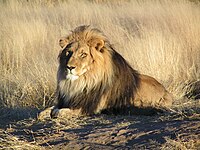
Photo from wikipedia
Due to the strong individual cost of being predated, potential prey species alter their behavior and physiology in response to predation risk. Such alterations may cause major indirect consequences on… Click to show full abstract
Due to the strong individual cost of being predated, potential prey species alter their behavior and physiology in response to predation risk. Such alterations may cause major indirect consequences on prey populations that are additive to the direct demographic effects caused by prey being killed. However, although earlier studies showed strong general effects of the presence of apex predators, recent data suggest that indirect effects may be highly context dependent and not consistently present. We combined behavioral data with data on endocrine stress and stable isotopes to assess landscape level effects of lion (Panthera leo) presence on two prey species in South Africa, impala (Aepyceros melampus) and blue wildebeest (Connochaetes taurinus). We also evaluated if there was any seasonal variation in such effects. In addition, we provide results from a physiological validation for an enzyme-linked immunoassay (EIA) that can be used for non-invasive monitoring of glucocorticoid stress metabolite concentrations in impala from fecal pellets. We did not find any significant differences in vigilance behavior, fecal glucocorticoid metabolite concentrations, 13C values or isotope niche breadth between animals living with and without lions for either species. However, wildebeest living in a reserve with lions spent more time foraging compared to wildebeest in a lion-free environment, but only during the wet season. Values of fecal 15N suggest a shift in habitat use, with impala and wildebeest living with lions potentially feeding in less productive areas compared to animals living without lions. For both species, characteristics of the social groups appeared to be more important than individual characteristics for both foraging and vigilance behavior. Our results highlight that antipredator responses may be highly dynamic and scale-dependent. We urge for further studies that quantify at what temporal and spatial scales predation risk is causing indirect effects on prey populations.
Journal Title: Frontiers in Ecology and Evolution
Year Published: 2018
Link to full text (if available)
Share on Social Media: Sign Up to like & get
recommendations!